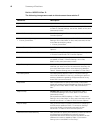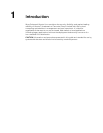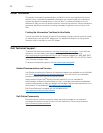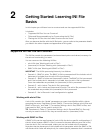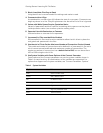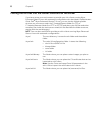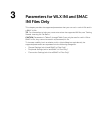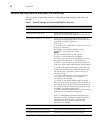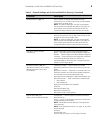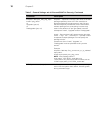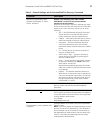
4 Chapter 2
in both the wlx.ini file and the $MAC.ini file but is defined differently (different values for
the same parameter).
For example, if the wlx.ini file has parameterA=valueB, and the $MAC.ini file has the
same parameterA=valueC, then:
- If the include=wlx.ini parameter is included in the $MAC.ini file before the
parameterA=valueC statement, then the wlx.ini parameterA=valueB is discarded and
parameterA=valueC (from the $MAC.ini file) is the final value used.
- If the include=wlx.ini parameter is included in the $MAC.ini file after the
parameterA=valueC statement, then the $MAC.ini parameterA=valueC is discarded and
parameterA=valueB (from the wlx.ini file) is the final value used.
Working with {username}.ini Files
A {username}.ini file contains the user-specific or “user profile” parameters you want
that will comprise the connection profile for an individual user. These parameters will
affect only the user you specify. Parameters in Table 7, "Connection Settings: wlx.ini
files, $MAC.ini files, and {username}.ini files," can be used in a {username}.ini file.
TIP: “User profile” parameters (found in the {username}.ini file) generally override the
identically named “global” parameters (found in the wlx.ini file), however, some “global”
parameters do not allow this (for hierarchical precedence of one variable over another,
refer to the parameter descriptions in Table 7, "Connection Settings: wlx.ini files,
$MAC.ini files, and {username}.ini files,").
CAUTION: If both PNAgent/PNLite and a user profile are being used in the
environment, the username must be defined in the Windows domain to be used, and
the password used must be the same for both the Windows domain and the user
profile.
Rules and Recommendations for Constructing the INI Files
In general, Wyse Enhanced Ubuntu INI files follow currently accepted “standard” INI file
formatting conventions. The INI files consist of Wyse parameters. Any of the parameters
can be used if you desire, but are not necessary unless you want changes from client
and “other” defaults (for example, “other” can be the default resolution of your
monitor). Every parameter (and their options) has a name and a value, with the name
appearing to the left of the equals sign (name=value). All parameters with the same
name in the various INI files have the same meaning (that is, a parameter named
WyseXYZ in a wlx.ini file and named WyseXYZ in a {username}.ini file will have the same
meaning). Number signs (#) indicate the start of a comment. Comments can begin
anywhere on a line. Everything between the # and the End of Line is ignored. Along
with these general formatting conventions, use the following guidelines when
constructing the INI files:
1. Global Connect Parameters First
Global connect parameters should be listed before other connect parameters in a
wlx.ini file.
2. Continue Lines with a Space and Backslash
Placing a space and backslash ( \) at the end of a line indicates line continuation;
that is, the backslash means that the line and the following line are, for the purposes
of reading code, the same line. No white space can appear after the backslash; the
requirement of white space between parameter entries is maintained by the use of
the space before the backslash. In addition, starting all parameters at the left margin
and placing at least one leading space (or tab) at the beginning of all (and only)
continuation lines makes an INI file easier to read.
Note that in circumstances where you require string concatenation, you can use a
backslash without a space before or after it to concatenate with the first set of
characters from the previous line; for example the strings snow and ball may be
concatenated to give snowball.





